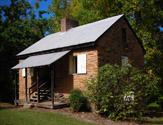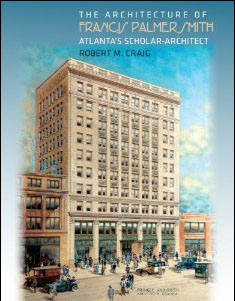















Southern Press
A Review of
The Architecture of Francis Palmer Smith
Atlanta's Scholar Architect
(Robert M. Craig; Athens and London: University of Georgia Press, 2012.)
The Architecture of Francis Palmer Smith
Atlanta's Scholar Architect
(Robert M. Craig; Athens and London: University of Georgia Press, 2012.)
In his latest work, The Architecture of Francis Palmer Smith: Atlanta's Scholar Architect, Robert M. Craig, professor emeritus of architectural history at the Georgia Institute of Technology, presents an exhaustive account of the career of famed Atlanta architect Francis Palmer Smith (1886-1971). Richly detailed and beautifully illustrated, the book is an essential point of reference for students of Atlanta architecture and history alike. Best of all, Craig's book -- one that is neither dumbed down nor overwhelmingly complicated -- is palatable to readers from all levels of interest in architecture.
Hardly a boring, cumbersome tome or another dust-catching photo album chock-full of the all too familiar pictures of slaves laboriously picking cotton (or disturbing images of lifeless black men hanging from trees as their white executioners, no doubt proud of their actions, casually gather below), Freedom explores the African American journey from the slave house to the White House. A virtual treasury of documented history, this book examines the plight of early blacks, honors those whose efforts changed a society and celebrates the lives of those who overcame social or economic adversities, rising to prominence in their respective fields.
If a single picture is worth a thousand words, the value of this book, which contains hundreds of photographs, is immeasurable. Daring to feature unfortunate aspects of America's past that some downplay even today and, still, others would rather forget, Freedom uncovers the shameful, wicked countenance of bigotry, evoking pity and helpless compassion for its past victims while inciting rage against those who foolishly perpetuate hatred and racial prejudice.
Unforgettable images captured include those of a freed slave whose bare, mutilated back discloses his former treatment by an oppressive, sadistic owner; the bullet-riddled, burning body of a black man accused of assaulting a white girl in Omaha, Nebraska, in 1919; a grief-stricken Mamie Till at the funeral of her 14-year-old son Emmett who had been abducted, brutally tortured and murdered for allegedly whistling or 'familiarly' speaking to a white woman in August 1955; and a young woman's face feeling the brunt of a fellow black's open hand as they prepare for the "physical abuse and vigilante violence that frequently occurred in civil rights organizing efforts in the Deep South" during the 1960s.
But not every photograph is poignant, unsettling or repulsive and, along the way, African Americans have seen their share of triumphs in spite of persecutions and violence. A picture taken in London in 1872 depicts Nashville's renowned Fisk Jubilee Singers who popularly performed spirituals before white audiences throughout the Midwest and Eastern U.S. as well as Europe. Captured in 1939 is an amazing view of around 75,000 gathered at the Lincoln Memorial in Washington to hear a black woman sing-in this case the elegant and beautiful Marian Anderson. Then, there is a shot of a strong, stoic Coretta Scott King, taken on April 16, 1968 in the midst of intense heartbreak and sadness, marching in Memphis for better working conditions for the city's sanitation workers. Her husband, civil rights leader Dr. Martin Luther King, Jr., was to lead the peaceful protest, but was gunned down just days earlier. (The demonstration, incidentally, was effective and Memphis reached a settlement with its workers.)
If a single picture is worth a thousand words, the value of this book, which contains hundreds of photographs, is immeasurable. Daring to feature unfortunate aspects of America's past that some downplay even today and, still, others would rather forget, Freedom uncovers the shameful, wicked countenance of bigotry, evoking pity and helpless compassion for its past victims while inciting rage against those who foolishly perpetuate hatred and racial prejudice.
Unforgettable images captured include those of a freed slave whose bare, mutilated back discloses his former treatment by an oppressive, sadistic owner; the bullet-riddled, burning body of a black man accused of assaulting a white girl in Omaha, Nebraska, in 1919; a grief-stricken Mamie Till at the funeral of her 14-year-old son Emmett who had been abducted, brutally tortured and murdered for allegedly whistling or 'familiarly' speaking to a white woman in August 1955; and a young woman's face feeling the brunt of a fellow black's open hand as they prepare for the "physical abuse and vigilante violence that frequently occurred in civil rights organizing efforts in the Deep South" during the 1960s.
But not every photograph is poignant, unsettling or repulsive and, along the way, African Americans have seen their share of triumphs in spite of persecutions and violence. A picture taken in London in 1872 depicts Nashville's renowned Fisk Jubilee Singers who popularly performed spirituals before white audiences throughout the Midwest and Eastern U.S. as well as Europe. Captured in 1939 is an amazing view of around 75,000 gathered at the Lincoln Memorial in Washington to hear a black woman sing-in this case the elegant and beautiful Marian Anderson. Then, there is a shot of a strong, stoic Coretta Scott King, taken on April 16, 1968 in the midst of intense heartbreak and sadness, marching in Memphis for better working conditions for the city's sanitation workers. Her husband, civil rights leader Dr. Martin Luther King, Jr., was to lead the peaceful protest, but was gunned down just days earlier. (The demonstration, incidentally, was effective and Memphis reached a settlement with its workers.)
With a love for medieval architecture and an educational background steeped in the Beaux-Arts tradition, Smith, began his career as an educator, directing Georgia Tech's department of architecture from 1909 to 1922. Future architects of note such as Ed Ivey, Lewis Crook and Philip Schutze were among his students. During his early years, he also designed and built collegiate buildings for Georgia Tech and worked closely with architect W. T. Downing, subsequently becoming acquainted with future business partner Robert Smith Pringle.
In 1922, Smith joined forces with Pringle to establish a preeminent architectural firm which Craig explains was "one of the most active in Atlanta during the 1920s and was responsible for some of the most noteworthy projects in the city and the region." Examining their prolificity, Craig indicates that Pringle and Smith "would have more than two hundred projects in the firm's books, from private houses and large hotels to commercial skyscrapers and other office and retail buildings" between 1922 and 1930. Buildings of note included Atlanta's Carlton Bachelor Apartments (1924-25; later the Cox Carlton Hotel, now a Hotel Indigo, adjacent to the Georgian Terrace Hotel), the Norris Building (1926; replaced by Peachtree Center), the Rhodes-Haverty Building (1928-29; currently the Marriott Residence Inn-Downtown) and the William-Oliver Building (1930), as well as Miami's elegant Venetian Hotel (1924-25; razed).
In 1922, Smith joined forces with Pringle to establish a preeminent architectural firm which Craig explains was "one of the most active in Atlanta during the 1920s and was responsible for some of the most noteworthy projects in the city and the region." Examining their prolificity, Craig indicates that Pringle and Smith "would have more than two hundred projects in the firm's books, from private houses and large hotels to commercial skyscrapers and other office and retail buildings" between 1922 and 1930. Buildings of note included Atlanta's Carlton Bachelor Apartments (1924-25; later the Cox Carlton Hotel, now a Hotel Indigo, adjacent to the Georgian Terrace Hotel), the Norris Building (1926; replaced by Peachtree Center), the Rhodes-Haverty Building (1928-29; currently the Marriott Residence Inn-Downtown) and the William-Oliver Building (1930), as well as Miami's elegant Venetian Hotel (1924-25; razed).

Author's Note: Like myself, Robert M. Craig has contributed to the New Georgia Encyclopedia. His NGE entry, "Late Victorian Architecture: Overview," has proven to be an invaluable reference in my writing of various Southern Edition articles, including: The Ponce de Leon Apartments: One of Atlanta's Most Distinguished and Endangered Properties.
And, lastly, there are those pictures of blacks who have achieved the once impossible. These include that of a jubilant and glamorous Oprah Winfrey whose entertainment enterprise has garnered her international acclaim and a billion dollar fortune. Also featured is a photo taken at a meeting of the National Security Council in the Cabinet Room of the White House in which two of the most politically powerful African Americans in history-Colin Powell and Condoleeza Rice-are seated with the president. Pundits and political columnists have speculated for quite some time whether the nation's first black president or vice president might be Powell or Rice. Only time will tell.

Craig writes, "By the eve of the Depression, Pringle and Smith were arguably the dominant architects in Atlanta for tall-building design, and with their Atlanta commercial work of about 1930, they would become leaders in bringing the popular phase of Modernism, later labeled 'Art Deco,' to what was emerging as the largest city in the Southeast." Additionally, Pringle and Smith, as Craig states, served as consulting architects for projects such as Willis Irvin's Forest Hills-Ricker Hotel (razed) in Augusta and Baumann & Baumann's Tennessee Terrace Hotel (later the Andrew Johnson Hotel) in Knoxville.
Pringle and Smith residential designs, at which Craig takes a most fascinating look, included homes for prominent Atlantans such as Ivan Allen Sr. and wealthy Chattanoogans, J. Frank Harrison and Mrs. D. M. Patten.
Upon Pringle's retirement in 1934, Smith continued to build various private residences, Coca Cola bottling plants and churches. Among his most important ecclesiastical projects were Atlanta's Druid Hills Presbyterian Church and the Cathedral of St. Philip. Interestingly, the former, located beside the old Briarcliff Hotel along Ponce de Leon Avenue, features the stained glass work of Philadelphia-based Willet Studios, including the choir window Smith designed and dedicated to the memory of his wife, Ella (1886-1930). The Gothic Revival Cathedral of St. Philip, which Craig calls "Smith's masterpiece of church architecture and the climax of his long architectural practice," is situated in the affluent Buckhead neighborhood within walking distance of today's luxury hotels and high-rise condominiums (including Park Place where Sir Elton John maintains a part-time residence).
In conclusion, Craig writes,"...Smith ensured that his buildings were scaled for human use. They might be intimate and domestic or monumental and powerful as civic expressions, but to experience these buildings is to know that his standard was always 'good architecture.'"
In The Architecture of Francis Palmer Smith: Atlanta's Scholar Architect, Craig has capably chronicled Smith's body of work, compelling the reader to develop a newfound appreciation for Smith's designs and the impact they made on the landscape of Atlanta, Chattanooga and elsewhere.
*Craig is also the author of Bernard Maybeck at Principia College: The Art and Craft of Building and Atlanta Architecture: Art Deco to Modern Classic, 1929-1959, and coauthor, with Paul Goldberger, of John Portman: Art and Architecture.
Author: Greg Freeman. Published July 8, 2012.
Pringle and Smith residential designs, at which Craig takes a most fascinating look, included homes for prominent Atlantans such as Ivan Allen Sr. and wealthy Chattanoogans, J. Frank Harrison and Mrs. D. M. Patten.
Upon Pringle's retirement in 1934, Smith continued to build various private residences, Coca Cola bottling plants and churches. Among his most important ecclesiastical projects were Atlanta's Druid Hills Presbyterian Church and the Cathedral of St. Philip. Interestingly, the former, located beside the old Briarcliff Hotel along Ponce de Leon Avenue, features the stained glass work of Philadelphia-based Willet Studios, including the choir window Smith designed and dedicated to the memory of his wife, Ella (1886-1930). The Gothic Revival Cathedral of St. Philip, which Craig calls "Smith's masterpiece of church architecture and the climax of his long architectural practice," is situated in the affluent Buckhead neighborhood within walking distance of today's luxury hotels and high-rise condominiums (including Park Place where Sir Elton John maintains a part-time residence).
In conclusion, Craig writes,"...Smith ensured that his buildings were scaled for human use. They might be intimate and domestic or monumental and powerful as civic expressions, but to experience these buildings is to know that his standard was always 'good architecture.'"
In The Architecture of Francis Palmer Smith: Atlanta's Scholar Architect, Craig has capably chronicled Smith's body of work, compelling the reader to develop a newfound appreciation for Smith's designs and the impact they made on the landscape of Atlanta, Chattanooga and elsewhere.
*Craig is also the author of Bernard Maybeck at Principia College: The Art and Craft of Building and Atlanta Architecture: Art Deco to Modern Classic, 1929-1959, and coauthor, with Paul Goldberger, of John Portman: Art and Architecture.
Author: Greg Freeman. Published July 8, 2012.
Copyright
Southern Edition
All Rights Reserved
Southern Edition
All Rights Reserved
All materials contained on this site, including text and images, are protected by copyright laws and may not be reproduced without prior written permission from the publisher. Where applicable, use of some items contained on this site may require permission from other copyright owners.
Fair Use of text from SouthernEdition.com is permitted to the extent allowed by copyright law. Proper citation is requested. Please use this guide when citing a Southern Edition article.
Contact Greg Freeman or SouthernEdition.comFair Use of text from SouthernEdition.com is permitted to the extent allowed by copyright law. Proper citation is requested. Please use this guide when citing a Southern Edition article.